Bio 173 - Exam #2 Textbook Assigned reading notes
4/26/24 - 29.5 & 46.4
Uptake of water and nutrients by roots
plants obtain nutrients from the soil
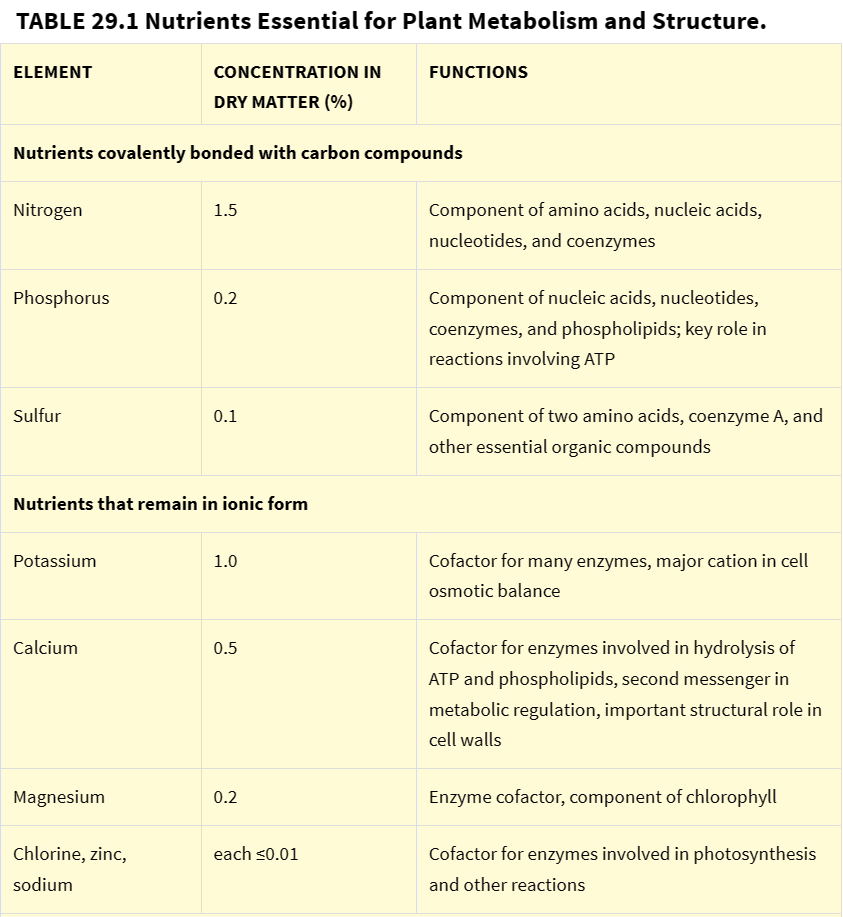
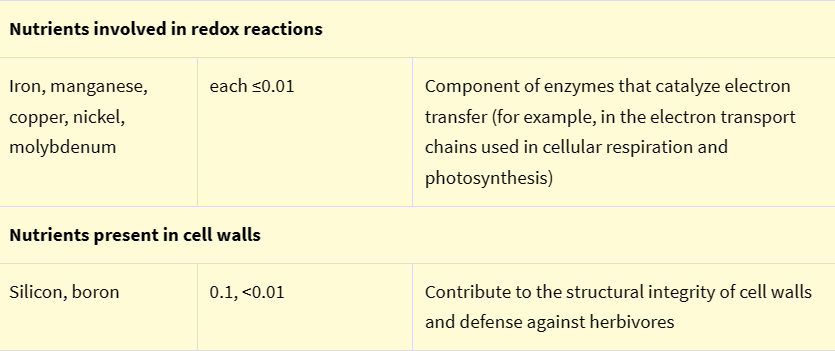
nutrient uptake by roots is highly selective
uptake of water and nutrients takes place in actively growing roots, the root hairs
the endodermis and Casparian strip prevent any unwanted material to travel through the xylem and phloem
nutrient uptake requires energy
the mitochondria of the root cell must respire at a high rate to provide the energy needed for nutrient uptake
root and root hairs need to elongate because both structure increase the volume of soil from which a root can obtain nutrients when the diffusion is not being driven in the plant’s favor
soil is more likely to bind to positively charged molecules which are necessary components to the plant so it will release compounds that make the rhizosphere more acidic to obtain the highly immobile nutrients
mycorrhizae enhance nutrient uptake
ectomycorrhizae & endomycorrhizae
fungal networks have better access between soil particles since they are very thin, greatly increase the absorptive SA in contact with the soil
the fungi can secrete enzymes that make soul nutrients more available
these associations can be costly: 4%-20% of C supply
symbiotic nitrogen-fixing bacteria supply nitrogen to both plants and ecosystems
nitrogen fixation is a process that some bacteria and archaea convert N2 gas from the atmosphere into ammonia
a root nodule is formed when chemicals in the soil trigger the root cells to divide where the nitrogen-fixing bacteria are housed to supply the plant with a source of nitrogen while it receives carbohydrates (25%) in return
nitrogen availability has a large impact on agricultural productivity
Nitrogen-Cycle
assimilation: primary producers converting atmospheric N2 to nitrate, ammonia, or ammonium in the soil
ammonification: the return of biological nitrogen to the environment as ammonia during the breakdown of organic matter by decomposers
denitrification: the process in which bacteria use nitrate as an electron acceptor in CR (anaerobic) to release N2 to the environment
nitrification: the process by which chemoautotrophic bacteria oxidize ammonia to nitrite and then nitrate
anammox: energy metabolism found in some bacteria in which ammonium ions are oxidized by nitrite with N2 gas as a byproduct
anaerobic ammonia oxidation
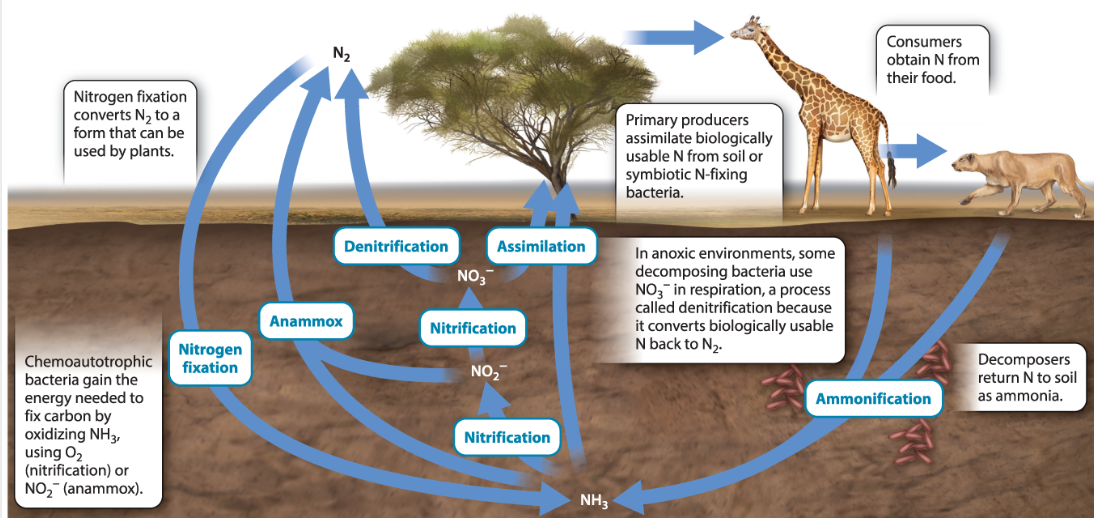
Phosphorus cycle
mainly found in rocks, does not provide electron donors or electron acceptors for energy metabolism
enters the food web as phosphate ions released by rocks from chemical weathering and then assimilated by primary producers
transferred from organisms by consumption and decomposition until to returns to geologic reservoirs by accumulation in sediments
4/30/24 & 5/2/24 - 30.4, 30.5, 30.6
plant hormones
hormones affect the growth and differentiation of plant cells
two roles: they help establish and maintain basic patterns of the plant body plan and they coordinate growth in different parts of the plant in response to both external and internal factors
an example includes leaf arrangement and branch formation and the length of elongation for the internodes
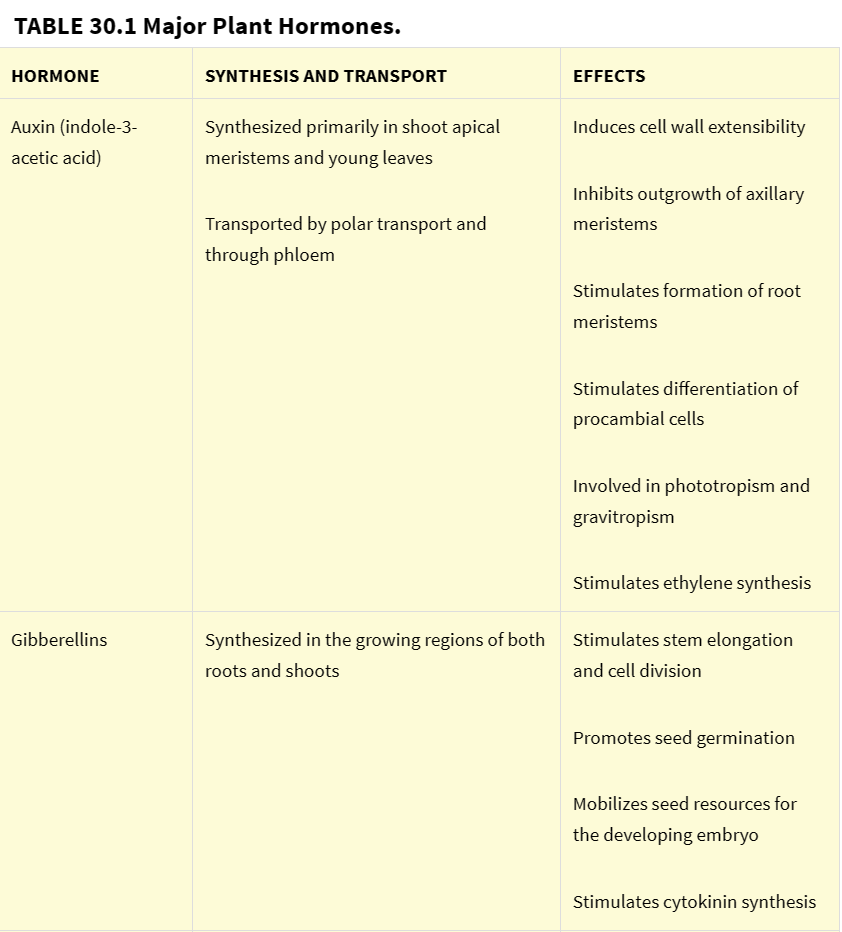
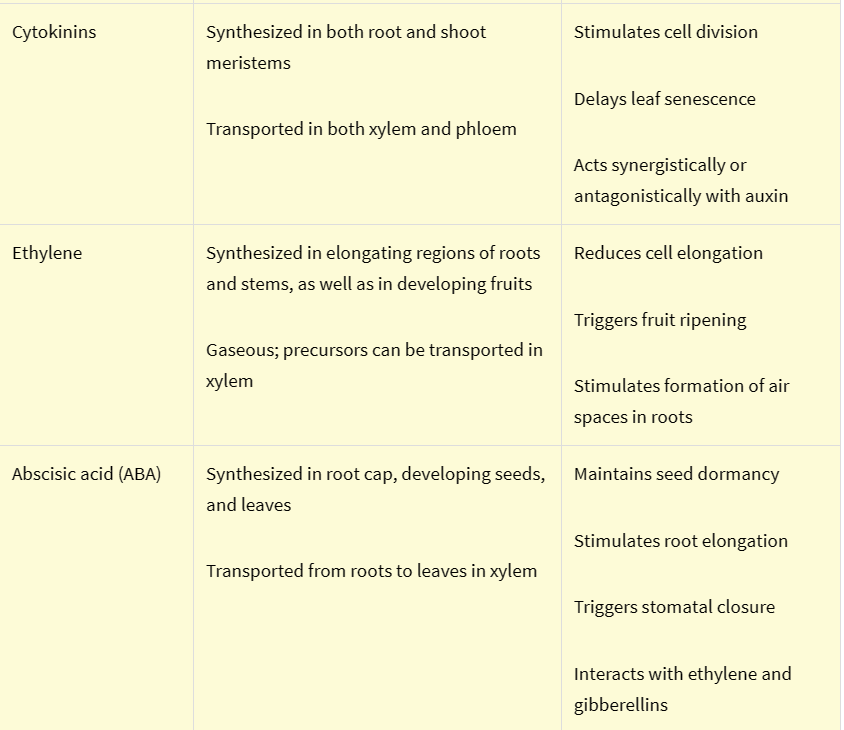
polar transport of auxin guides the development of vascular connections between leaves and stems
this hormone has a role in patterning results that is controlled by the net movement of this hormone creates region of high and low conc
gibberellins stimulate internode elongation by reducing the force needed to cause cell walls to expand
cytokinin’s control the outgrowth of branches
this hormone is produced in the plant meristems and axillary buds
the shoot apical meristems suppress the growth of axillary buds (apical dominance)
the environmental context of growth and development
plants rely on photoreceptors to provide information of their surroundings
photoreceptors sense the availability of light needed to drive photosynthesis
mechanical receptors sense physical influences
chemical receptors detect the presence of certain chemicals / chemical gradients
plants orient the growth of their stems and roots by light and gravity
trophism: the bending of an organism in response to a directional signal such as light of gravity
plant stems are positively phototrophic (toward the light)
plant stems are negatively gravitropic (growth upward against gravity)
plant roots are positively gravitropic and negatively phototrophic
the photoreceptors that trigger phototropism absorb blue wavelengths of light
if only exposed on one side of the plant, only photoreceptors that side are activated
conc of auxin will be higher on the side with more shade and lower on the side intercepting the blue light (this is because auxin stimulates cell expansion in stems so the shoot grows faster on the shaded side than the illuminated side ~ causes the bend TOWARDS light)
the accumulation of auxin on the lower surface causes stems to bend up and roots to turn down
plants are able to tell which way is down due to starch globules called statoliths that are specialized gravity-sensing cells in the root cap which orient the growth of the root downwards
seeds can delay germination if they detect the presence of plants overhead
as sunlight passes through leaves, the plant absorbs the red wavelength by the chlorophyll but the far-red wavelengths aren’t
the plant can detect higher levels of competition if the far-red wavelengths are being reflected by other plants around it
phytochrome is a photoreceptor that switches back & forth between two stable forms red light wavelength: Pr and Pfr (active form)
Pfr is converted to Pr very slowly at night by moving from the cytoplasm to the nucleus where it gets altered of gene pattern expression
plants grow taller and branch less when growing in the shade of other plants
roots elongate more and branch less when water is scarce
roots penetrate further into the soil when no available water at their current location and being deeper in the substrate increases the plant’s chances of reaching moister soil
if there is a water shortage or conditions alike a drought, the roots will secrete abscisic acid which stimulates the stomata to close and conserve the water supply
exposure to wind results in shorter and stronger stems
the movement of the stem by external factors triggers an increase in the ethylene hormone which makes the plant having wider diameter stem
thigmotropism is a developmental response to a mechanical stimulus arising from physical contact
timing of developmental events
flowering time is affected by day length
photoperiodism is the effect of the day length on physiological or developmental processes ~ the effect of day length on flowering
a short-day plant is a plant that flowers only when the day length is less than a critical value and they measure the length of the dark period (usually bloom late-summer)
a long-day plant is a plant that flowers only when the duration of the light period exceeds a critical value and they measure the length of the dark period (usually bloom late spring or early summer)
a day-neutral plants is a plant that flowers independently of any change in the day length
vernalization prevents plants from flowering until winter has passed
vernalization is a long prolonged period of exposure to cold temps necessary to induce flowering in some plants
these plants “remember” winter conditions due to chromatin modifications
plants use day length as a cue to prepare for winter
day length can trigger developmental events like the change of seasons prompts the plant to form storage organs in their roots or overwintering buds to prepare for winter
the plant will stop producing photosynthetic tissue and instead form bud scales which accompanies a metabolic change in the plant that allow meristems to remain dormant over winter
5/3/24 - 40.2
excretion of wastes
excretion is the elimination of waste products and toxic compounds from the body
the kidneys function to maintain water & electrolyte balance and they eliminate waste products
the excretion of nitrogenous wastes is linked to an animal’s habitat and evolutionary history
one form of nitrogenous waste is ammonia NH3 which can disturb the pH balance of cells and damage neurons, can be very toxic
animals had to evolve biochemical pathways to convert ammonia to a less toxic form, urea which requires energy to dilute
ammonia can also be converted to uric acid which is the form of N waste reptiles and birds excrete which eliminates any water loss or need to dilute their waste with their water supply
excretory organs work by filtration, reabsorption, and secretion